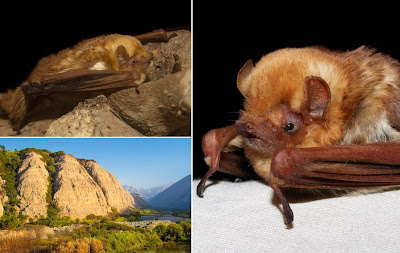 |
| Lasiurus arequipae
Málaga, Díaz, Arias & Medina, 2020
|
Abstract
A new species within the genus Lasiurus is proposed from 3 specimens collected in the coastal desert and western
slopes of southwestern Peru. Based on molecular and morphological evidence, the new species is related to Lasiurus
reddish species (i.e., L. atratus, L. castaneus, L. blossevillii, and L. varius). Cytochrome b genetic divergence between
the new species and the other species of the genus was high (> 9.4%). This new species, endemic to Peru, increases
the known diversity of Lasiurus to 20 species.
Keywords: Arequipa cinnamon red bat; Coastal desert; Phylogeny; Genetic divergence; Cytochrome b
 |
| Figure 1. Individual of Lasiurus arequipae sp. nov. (MUSE 21891) collected in Huatiapa, Castilla, Arequipa. |
 |
| facebook.com/BrianMalagaTellez |
Order Chiroptera Blumenbach, 1779
Family Vespertilionidae Gray, 1821
Genus Lasiurus Gray, 1831
Lasiurus arequipae sp. nov. Málaga, Díaz, Arias & Medina
Murciélago acanelado de Arequipa
Arequipa Cinnamon Red Bat
 |
| Figure 4. Habitat of Lasiurus arequipae sp. nov. (MUSE 21058 and MUSA 21891). |
Etymology: the specific epithet "arequipae" is given in honor of the White City of Arequipa, located in the southwest of Peru, whose historical center was recognized as World Heritage by the United Nations Educational, Scientific and Cultural Organization (UNESCO) in November 2000. It should be noted that in the department of Arequipa find the deepest canyons in the world, canyons Cotahuasi and Colca, which define the ranges of distribution of various species of flora and fauna in the western slope of the Andes (Pearson, 1982).
Resumen: Se propone una nueva especie dentro del género Lasiurus a partir de 3 ejemplares recolectados en el desierto costero y vertiente occidental del sur de Perú. Basados en evidencia molecular y morfológica, Lasiurus sp. nov. está relacionada con especies rojizas del género Lasiurus (i.e., L. atratus, L. castenaeus, L. blossevillii y L. varius). La divergencia genética del gen citocromo b entre la nueva especie y las otras especies del género fueron altas (> 9.4%). Esta nueva especie, endémica de Perú, incrementa la diversidad conocida del género Lasiurus a 20 especies.
Palabras clave: Murciélago acanelado de Arequipa; Desierto costero; Filogenia; Divergencia genética; Citocromo b
Brian A. Málaga, Darwin R. Díaz, Sandra Arias and César E. Medina. 2020. Una especie nueva de Lasiurus
(Chiroptera: Vespertilionidae) del suroeste de Perú [A new species of Lasiurus (Chiroptera: Vespertilionidae)
from southwestern Peru]. Revista Mexicana de Biodiversidad. 91: e913096. revista.ib.unam.mx/index.php/bio/article/view/3096/




